
Mission San Buenaventura, formally known as the Mission Basilica of San Buenaventura, is a Catholic parish and basilica in the Archdiocese of Los Angeles. The parish church in the city of Ventura, California, United States, is a Spanish mission founded by the Order of Friars Minor. Founded on March 31, 1782, it was the ninth Spanish mission established in Alta California and the last to be established by the head of the Franciscan missions in California, Junípero Serra. Designated a California Historical Landmark, the mission is one of many locally designated landmarks in downtown Ventura.

Ventura, officially named San Buenaventura, is a city in and the county seat of Ventura County, California, United States. The population was 110,763 at the 2020 census. Ventura is a popular tourist destination, owing to its historic landmarks, beaches, and resorts.

The Ventura County Courthouse, known since 1974 as Ventura City Hall, is a historic building in Ventura, California. It is located on a hill at the top of California Street, overlooking the city's downtown district with views of the Santa Barbara Channel and Channel Islands. It was the first building in the City of Ventura to be listed on the National Register of Historic Places and has also received historic designations at the state, county and city levels.
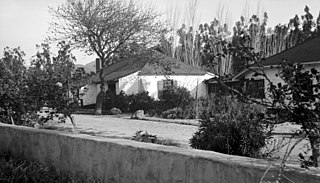
Rancho Camulos, now known as Rancho Camulos Museum, is a ranch located in the Santa Clara River Valley 2.2 miles (3.5 km) east of Piru, California and just north of the Santa Clara River, in Ventura County, California. It was the home of Ygnacio del Valle, a Californio alcalde of the Pueblo de Los Angeles in the 19th century and later elected member of the California State Assembly. The ranch was known as the Home of Ramona because it was widely believed to have been the setting of the popular 1884 novel Ramona by Helen Hunt Jackson. The novel helped to raise awareness about the Californio lifestyle and romanticized "the mission and rancho era of California history."
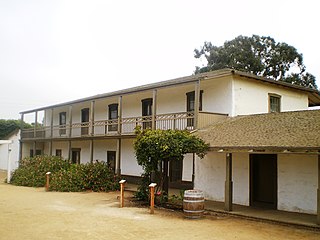
The Olivas Adobe in Ventura, California is an adobe structure built in 1837 by Raymundo Olivas on the north bank of the Santa Clara River about a mile from the estuary where it flows into the Santa Barbara Channel.

The Topatopa Mountains are a mountain range in Ventura County, California, north of Ojai, Santa Paula, and Fillmore. They are part of the Transverse Ranges of Southern California.

The San Buenaventura Mission Aqueduct was a seven-mile long, stone and mortar aqueduct built in the late 18th and/or early 19th century to transport water from the Ventura River to the Mission San Buenaventura in Ventura, California.

Elizabeth Bard Memorial Hospital, now known as The Elizabeth Bard Memorial Building, is a historic building in downtown Ventura, California. Built in 1901, it is a Mission Revival structure featuring covered terraces and a covered porch with a three-story bell tower at the southeast corner. The building was listed as Ventura Historic Landmark No. 19 in 1976 and was added to the National Register of Historic Places in 1977.

Rancho Las Vírgenes was a 17,760-acre (71.9 km2) land grant in the Santa Monica Mountains and Simi Hills, in present day western Los Angeles County, California. The lands of the Rancho Las Vírgenes included present day Agoura Hills, Oak Park, and Westlake Village and part of the Santa Monica Mountains.
Rancho Sespe was a 8,881-acre (35.94 km2) Mexican land grant in present-day Ventura County, California given in 1833 by Governor José Figueroa to Carlos Antonio Carrillo. The grant encompassed the Santa Clara River Valley between Piru Creek on the east and Santa Paula Creek on the west, and was bounded to the north and south by the mountains, and included present day Fillmore.
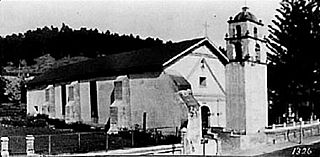
The City of Ventura Historic Landmarks and Districts consist of buildings, sites, and neighborhoods designated by the City of Ventura, California, as historic landmarks and districts.
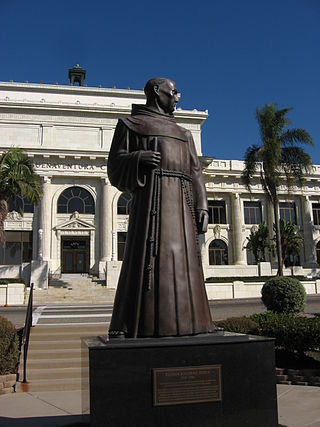
A statue in Ventura, California, representing Junípero Serra, the founder of Mission San Buenaventura, was commissioned by Ventura County through the Works Progress Administration as part of the Federal Art Project in 1935. This statue, made of concrete from a clay model by Uno John Palo Kangas, was placed in a prominent location in a public park across the street from the Ventura County Courthouse in 1936. After the Courthouse was repurposed as Ventura City Hall, the statue was designated as City of Ventura Historic Landmark No. 3 in 1974. As deterioration of the concrete statue became a concern, a wood replica was created by local carvers and used to make a bronze cast. The concrete statue was replaced by the bronze cast in 1989. The wood replica was set in the atrium of the city hall for public display.

The Serra Cross, sometimes also known as the Cross on the Hill or the Grant Park Cross, is a Christian cross on a hill known as "La Loma de la Cruz" in Ventura, California. The site is in Serra Cross Park, a one-acre parcel within the larger Grant Park that overlooks downtown Ventura, the Santa Barbara Channel, and Anacapa and Santa Cruz Islands.

The Peirano Market, also known as Peirano's Grocery and Peirano Store, is a historic building in Ventura, California. Located across the street from the Mission San Buenaventura, the red brick structure was built in 1877 and has ornamental relief brickwork and a mansard, Spanish revival tile roof.
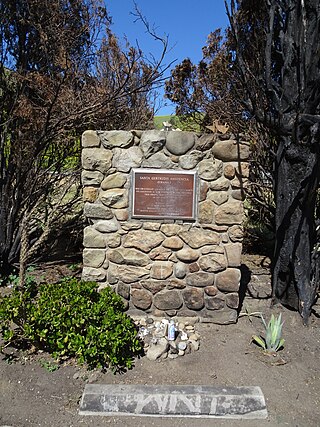
The Santa Gertrudis Asistencia, also known as the Santa Gertrudis Chapel, was an asistencia ("sub-mission") to the Mission San Buenaventura, part of the system of Spanish missions in Las Californias—Alta California. Built at an unknown date between 1792 and 1809, it was located approximately five miles from the main mission, inland and upstream along the Ventura River. The site was buried in 1968 by the construction of California State Route 33. Prior to the freeway's construction, archaeologists excavated and studied the site. A number of foundation stones were moved and used to create the Santa Gertrudis Asistencia Monument which was designated in 1970 as Ventura County Historic Landmark No. 11.

Eugene Preston Foster, commonly known as E. P. Foster, was a rancher, entrepreneur, banker, and philanthropist in Ventura County, California.
The Ortega-Vigare Adobe is second oldest adobe in the San Gabriel Valley, built in 1792. The Ortega-Vigare Adobe was designated a California Historic Landmark (No.632) on Nov. 2, 1949. The Ortega-Vigare Adobe is located is in what is now the City of San Gabriel, California in Los Angeles County at 616 S Ramona Street, San Gabriel, Cal.

The 1812 Ventura earthquake occurred on the morning of December 21 at 11:00 Pacific Standard Time (PST). The 7.1–7.5 magnitude earthquake, with a Modified Mercalli intensity scale rating of X (Extreme), along with its resulting tsunami, caused considerable damage to present-day Santa Barbara and Ventura County, California, which was at the time a territory of the Spanish Empire. One person was killed as a result of the earthquake while another from the aftershock. The earthquake occurred just as the region was recovering from another event on the 8th of December the same year. Both events are thought to have been related.

The Battle of San Buenaventura was a battle fought on March 27 and March 28, 1838, between forces representing competing claims to the governorship of California, then a Mexican territory. The opposing forces consisted of supporters of Juan Bautista Alvarado based in Northern California and supporters of Carlos Antonio Carrillo from Southern California. The major action consisted of a cannon siege on the Carrillo loyalists who were encamped at the Mission San Buenaventura in Ventura, California. The Alvarado forces won the battle, as the Carrillo forces fled from the Mission under cover of darkness following the first day of the battle. Most of the Carillo forces were captured the following day at Saticoy, California. One person was killed in the battle, an Alvarado loyalist who was shot by a rifleman stationed in the Mission's bell tower.



















